Chestnut-capped puffbird facts for kids
Quick facts for kids Chestnut-capped puffbird |
|
|---|---|
 |
|
| Conservation status | |
| Scientific classification | |
| Genus: |
Bucco
|
| Species: |
macrodactylus
|
 |
|
| Synonyms | |
|
|
The chestnut-capped puffbird (Bucco macrodactylus) is a special kind of bird. It belongs to a family of birds called Bucconidae, which includes puffbirds, nunlets, and nunbirds. You can find this bird in several countries, including Bolivia, Brazil, Colombia, Ecuador, Peru, and Venezuela.
Contents
About This Bird
What's in a Name?
Scientists like to group living things to understand them better. This is called taxonomy. The chestnut-capped puffbird has been placed in different groups (called genera) over time, like Bucco, Argicus, and Cyphos. Today, many scientists agree it belongs in the Bucco group. It's also considered a "monotypic" species, which means it's the only one of its kind in its group.
What Does It Look Like?
The chestnut-capped puffbird is a small bird, about 14 to 16.5 centimeters (5.5 to 6.5 inches) long. It weighs around 25 grams (about 0.9 ounces), which is like weighing a few quarters!
Its feathers are very unique:
- Its head (crown) is a rich chestnut color.
- The back of its neck (nape) is a bright reddish-orange.
- The rest of its upper body is brown, with lighter stripes on its back and many on its rump.
- It has a long, thin, dark brown tail.
- You'll see a thin white stripe above its eye.
- Its cheeks and lower throat are black, with a white line in between.
- Its chin and upper throat are reddish-white, and the feathers on its chin curl up over its beak.
- Below the black throat, there's a white band. The rest of its belly is a buffy color with thin dark stripes.
- Its beak is black, its eyes can be red or brown, and its feet are brownish-gray or greenish-gray.
Where Does It Live?
This puffbird lives in the upper Amazon Basin. This area covers parts of southern Venezuela, eastern Colombia, Ecuador, Peru, northern Bolivia, and western Brazil.
It likes many types of forests, but it usually stays close to water. You might find it in:
- Terra firme forests (forests on higher ground that don't flood).
- Várzea forests (forests that flood seasonally).
- Newer forests that are just starting to grow back.
- Secondary forests (forests that have grown back after being cut down).
- Gallery forests (forests that grow along rivers).
It can also live away from water in scrubby forests.
This bird usually stays fairly low in the trees, from the undergrowth (plants on the forest floor) to the subcanopy (the layer of trees below the main canopy). It often perches within 6 meters (20 feet) of the ground. It usually lives below 660 meters (2,165 feet) in elevation, but it has been seen as high as 1,000 meters (3,280 feet) in Peru and even 1,200 meters (3,937 feet) in Ecuador once!
How It Behaves
What Does It Eat?
The chestnut-capped puffbird finds its food by sitting on a perch and then flying out quickly to grab insects from plants. It has also been seen eating small vertebrates (animals with backbones).
How Does It Make a Home?
Scientists don't know much about how the chestnut-capped puffbird raises its young. One nest that was found was a hole inside a termitarium (a termite mound). This nest was about 2.5 meters (8 feet) up in a tree.
What Does It Sound Like?
The song of the chestnut-capped puffbird is a series of sad but sudden notes that get higher, ending in a quick twitter. It sounds like "pup pup pep pep peep peep pip pip pip piz."
Is It Safe?
The IUCN (International Union for Conservation of Nature) has looked at the chestnut-capped puffbird and decided it is a species of "Least Concern." This means it is not currently in danger of disappearing. It lives across a very large area, but we don't know exactly how many of these birds there are. Scientists believe their numbers might be going down. It is considered uncommon in some places and common in others.
See also
 In Spanish: Buco cabecirrojo para niños
In Spanish: Buco cabecirrojo para niños


